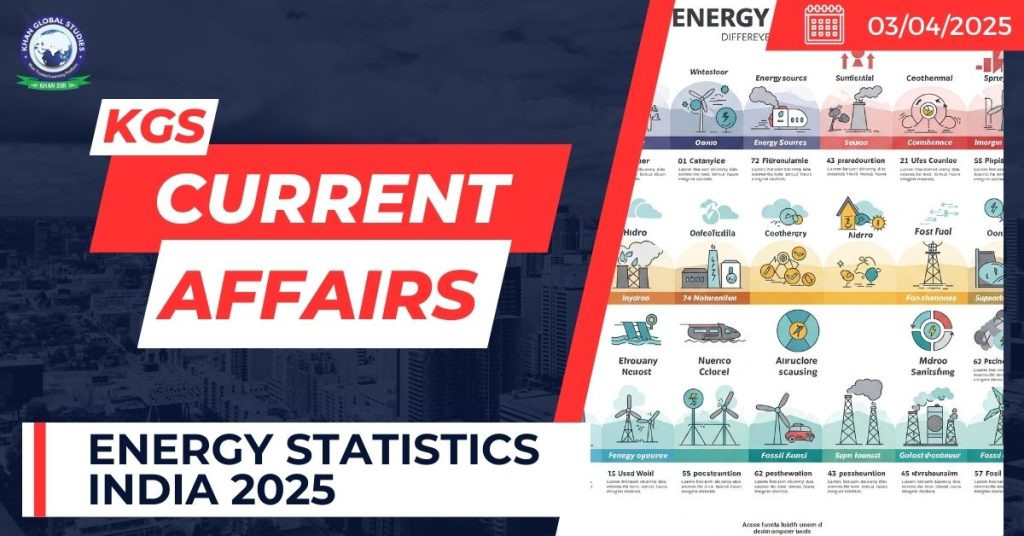Context:
Recently, the National Statistics Office (NSO), under Ministry of Statistics and Programme Implementation (MoSPI) has released the annual publication “Energy Statistics India 2025”.
More on the News
- This is 32nd edition of the Energy Statistics publication which offers a comprehensive overview of India’s energy sector progress.
- The Publication comprises of an integrated datasets containing diverse key information about reserve, capacity, production, Consumption, and import/export of various energy commodities (like Coal, Lignite, Petroleum, Natural Gas, Renewable Energy, etc.) in India.
- The current publication also contains a new chapter on Energy Account based on the System of Environmental Economic Accounting (SEEA), 2012 framework aiming for a structured representation of energy data within the economic and environmental contexts.
Key highlights of the Report
In the Financial Year 2023-24, India has experienced a steady and healthy growth in both energy supply and consumption by overcoming the shock of the global Pandemic.
The report noted that India’s installed capacity for electricity generation (utility and non-utility combined) reached 521.31 GW as of March 31, 2024 higher by 5.43% compared to the previous year.
Renewable energy sources (excluding large hydro) grew by 14.77% over the same period.

The major advancements in India’s energy sector is the improved efficiency in electricity utilization with successful reduction in transmission and distribution losses, which were brought down from 23% in 2014-15 to 17% in 2023-24.
Coal continues to be the primary energy source, with domestic production reaching 997.83 million tonnes (MT) in FY 2023-24, up by 11.71% from 893.19 MT in FY 2022-23.
- Non-coking coal accounted for 93.3% of the total production.
The reserves of Coal stood at 389.42 billion tonnes, of which Odisha has the highest share of 25.47 % followed by Jharkhand (23.58%), Chhattisgarh (21.23%).
Total primary energy supply (TPES) rose 7.8% in FY 2023-24, reaching 903.16 million tonnes of oil equivalent (KToe).
- Millions of tonnes of oil equivalent (Mtoe) is a unit of energy used to describe the energy content of all fuels, typically on a very large scale.
- Coal made up 60.21% of TPES, followed by crude oil (29.83%) and natural gas (6.99%).
The estimated Crude Oil reserves were 671.40 million tonnes of which Western Offshore accounted for around 32%, followed by Assam (21.66%), Rajasthan (19.59%) and Gujarat (17.70%).
Natural gas reserves stood at 1,094.19 billion cubic meters, led by Western Offshore (31%), Eastern Offshore (24%), and Assam (15%).
Refining capacity in India stood at 256.82 million tonnes per year as of March 31, 2024. The country had 23 refineries—19 in the public sector and four in private or joint venture categories.
Data related to Renewable Energy as of March 31, 2024.
- India ranks fourth globally in renewable energy installed capacity, fourth in wind power capacity, and fifth in solar power capacity, according to the International Renewable Energy Agency’s Renewable Capacity Statistics 2024.
- India has a huge potential for generation of renewable energy, which currently stands at 21,09,655 Megawatt, dominated by Wind energy (55.17%) followed by solar energy (35.50%), hydro energy (6.32%), Biomass (1.34%), Small Hydro (1%) and Bagasse (0.65%).
- Half of the India’s renewable energy potential is concentrated in four States of India viz. Rajasthan (20.3%), Maharashtra (11.8%), Gujarat (10.5%) and Karnataka (9.8%).
The government aims to install 500 GW of non-fossil-based power capacity by 2030 to meet 50% of the country’s electricity requirements from renewables.

